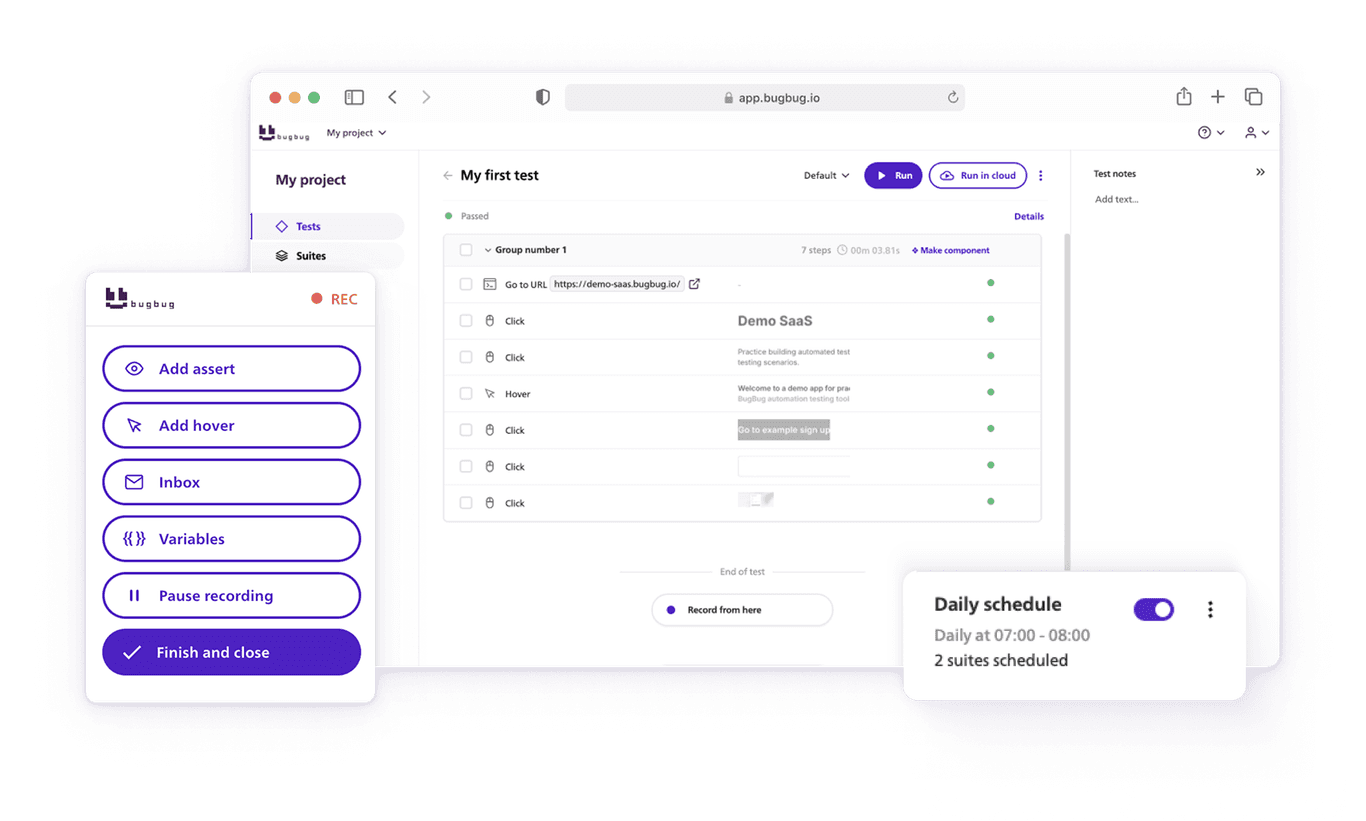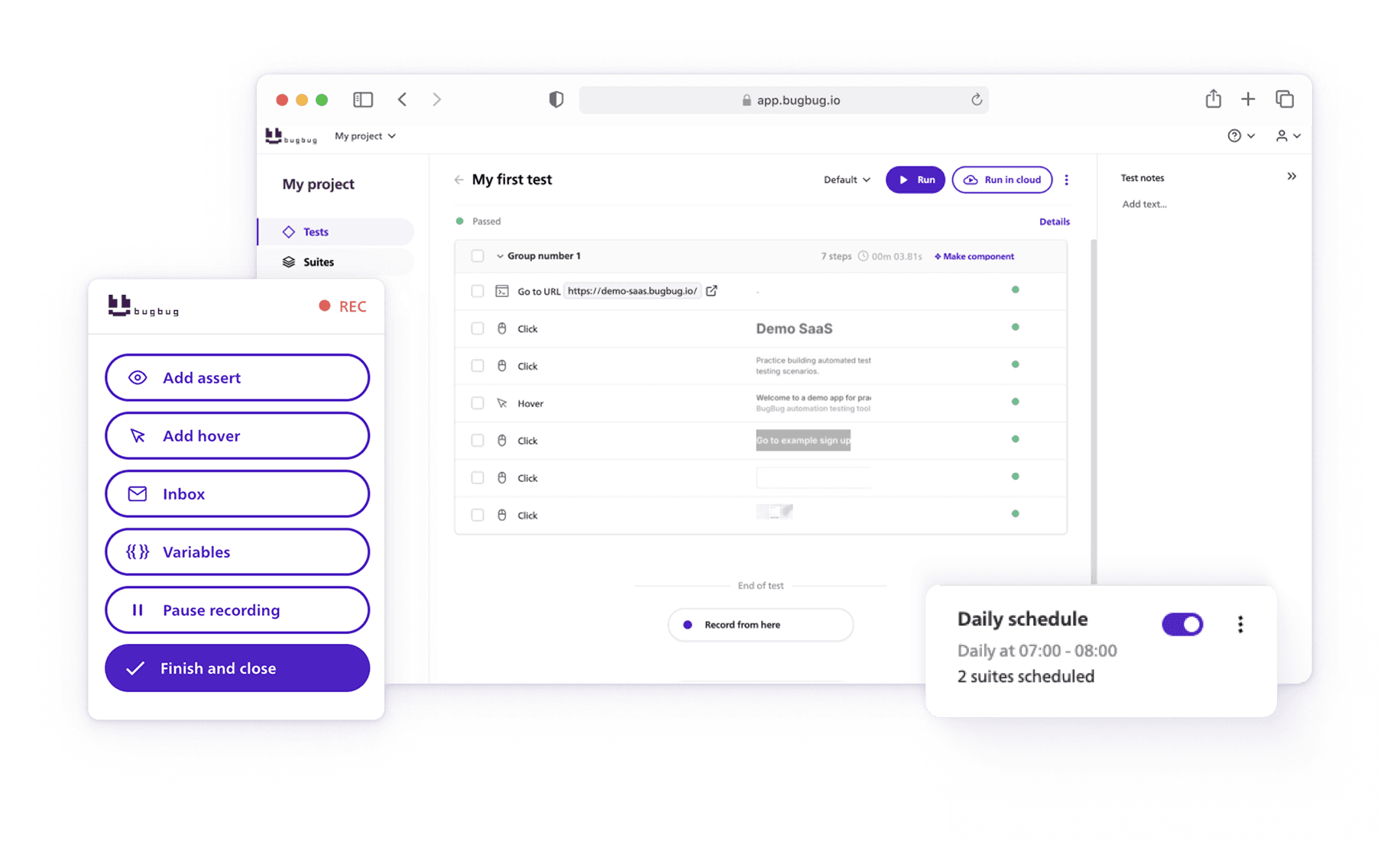🤖 Summarize this article with AI:
💬 ChatGPT 🔍 Perplexity 💥 Claude 🐦 Grok 🔮 Google AI Mode
- 🎯 TL;DR — When To Run Regression Tests?
- Why Timing Matters
- Quick Refresher: What Regression Testing Is (and Isn’t)
- Exactly When to Perform Regression Testing
- 1) After Every Feature or Code Change
- 2) Before Major Releases or Deployments
- 3) After Bug Fixes or Hotfixes
- 4) After Dependency or Runtime Updates
- 5) After Infrastructure / CI/CD / Environment Changes
- 6) After Database or Data Model Changes
- 7) After Integration or Third-Party Changes
- 8) After UX, Layout, or Content Updates
- 9) After Security or Compliance Updates
- 10) Around Operational or Seasonal Events
- 11) On a Regular Schedule (Continuous Regression)
- Quick Planner: Trigger → Suggested Suite
- Keeping Regression Efficient (and Sane)
- Automating Regression the Smart Way (with BugBug)
- Final Takeaway
🎯 TL;DR — When To Run Regression Tests?
✅ After new features, refactors, merges, or code changes
✅ Before releases, deployments, or migrations
✅ After bug fixes, hotfixes, or incident recoveries
✅ After dependency, framework, API, or environment updates
✅ After database, schema, or data-related changes
✅ After UI, content, localization, or accessibility updates
✅ After security, session, or permission model changes
✅ Before high-traffic events or seasonal releases
✅ On a regular (automated) schedule
Why Timing Matters
Regression testing is the safety net that ensures new work doesn’t break what already works. In agile/CI/CD, timing is as crucial as coverage:
- Too early: you miss issues introduced later in the cycle.
- Too late: you scramble under release pressure.
Aim for event-driven runs plus a regular cadence so you catch regressions continuously, not just at the end.
Quick Refresher: What Regression Testing Is (and Isn’t)
- Regression testing verifies that existing functionality still works after changes.
- It’s different from retesting, which verifies that a specific fix resolved a specific defect.
- Think of it as an ongoing guardrail for critical flows (login, checkout, onboarding, billing, etc.).
👉 Also check: Essential Web Application Testing Tools
Exactly When to Perform Regression Testing
Use this as a practical checklist for your QA cycle.
1) After Every Feature or Code Change
- Merged feature branches or refactors
- UI/layout/CSS tweaks; component prop/state changes
- Data handling, async logic, error handling updates
2) Before Major Releases or Deployments
- New app versions; sprint/milestone drops
- Infrastructure migrations
- Customer-facing changes (pricing, checkout, onboarding)
3) After Bug Fixes or Hotfixes
- Any functional fix (watch for nearby breakage)
- Production hotfixes, rollbacks, emergency patches
- Post-incident verification (recovery validated)
4) After Dependency or Runtime Updates
- Framework/library upgrades (React, Angular, Django, etc.)
- API version bumps; SDK updates
- Browser/OS updates; Node/Java/Python runtime changes
- Container base image updates (e.g., OpenSSL, libc)
5) After Infrastructure / CI/CD / Environment Changes
- Pipeline/test runner changes; env variable tweaks
- Deployment/scaling, cache/CDN, LB rule updates
- Queue/broker/message bus configuration
- Monitoring/APM tooling additions
6) After Database or Data Model Changes
- Schema migrations; new indexes/constraints
- ETL/import/export jobs
- Search indexing or caching logic changes
- Locale/currency/date formatting rules
- New reporting/analytics queries
7) After Integration or Third-Party Changes
- Payment gateways; auth/SSO providers
- API contracts/schemas
- Email/SMS/notification providers
- Rate limiting, firewall/WAF rules
- Tracking/analytics scripts
8) After UX, Layout, or Content Updates
- CSS/HTML/responsive breakpoints
- Accessibility/ARIA improvements
- SPA routing/navigation changes
- Localization (new languages/RTL)
- A/B tests or CMS template edits
9) After Security or Compliance Updates
- Session/cookie policy changes (SameSite/Secure)
- Role/permission model changes
- Auth libraries, encryption, consent/privacy banners
- Security patches and dependency upgrades
10) Around Operational or Seasonal Events
- Post-incident/data restoration checks
- Before peak traffic (sales, launches)
- Daylight savings/timezone transitions
- New tenant onboarding (multi-tenant)
- Before contract renewals/reporting cycles
11) On a Regular Schedule (Continuous Regression)
- Nightly/weekly runs to catch slow-moving/env issues
- Prevents last-minute “testing crunch” before release
Quick Planner: Trigger → Suggested Suite
| Trigger | What to Run |
|---|---|
| Feature branch merged | Targeted regression for impacted area + smoke of core flows |
| Pre-release / pre-deployment | Full regression of critical paths + cross-browser sanity |
| Hotfix in prod | Smoke + focused regression around impacted domain |
| Framework/API/dependency update | Broad regression of affected surfaces + integration/API checks |
| DB/schema change | Data-heavy flows, reporting, caching/indexing, i18n formatting |
| Security/session/permissions change | AuthN/AuthZ flows, session expiry, role-based access |
| UX/layout/content update | Responsive/UI journeys, forms/modals, a11y validations |
| High-traffic event imminent | Load-sensitive critical paths + payments and notifications |
| Weekly/nightly cadence | Rotating subsets + flaky test watchlist |
Scale test automation without code
Test easier than ever with BugBug test recorder. Faster than coding. Free forever.
Get started
Keeping Regression Efficient (and Sane)
- Scope smartly: Automate critical, stable flows first; expand by risk.
- Tier your suites: Smoke (minutes) → Critical regression (short) → Full regression (longer, scheduled).
- Fight flakiness: Prefer robust selectors, explicit waits, test-data isolation, and deterministic environments.
- Tag tests: By component/feature/risk so you can trigger just what’s needed per change.
- Measure & prune: Track failures/MTTR; delete or fix chronic flakes; merge overlapping tests.
Automating Regression the Smart Way (with BugBug)
Manual regression is repetitive and slow. Codeless automation makes it continuous and maintainable:
- Record & edit tests visually in the browser.
- Schedule runs after deployments or on a cadence.
- Integrate with CI/CD or trigger via API/webhooks.
- Debug quickly with Edit & Rewind to stabilize suites.
Result: reliable, low-maintenance regression that keeps pace with your delivery speed.
Final Takeaway
Regression testing isn’t about testing more—it’s about testing at the right moments. Combine event-driven triggers with a regular automated cadence to ship confidently, week after week. Tools like BugBug help you get there without drowning in setup or upkeep.
Sample Tagging Strategy
-
@smoke: login, signup, checkout, payments, dashboard load -
@critical: search, filters, add-to-cart, profile update, invoices -
@integration: webhooks, third-party APIs, auth/SSO -
@data: migrations, reports, exports, localization -
@security: roles/permissions, session/cookies
Happy (automated) testing



